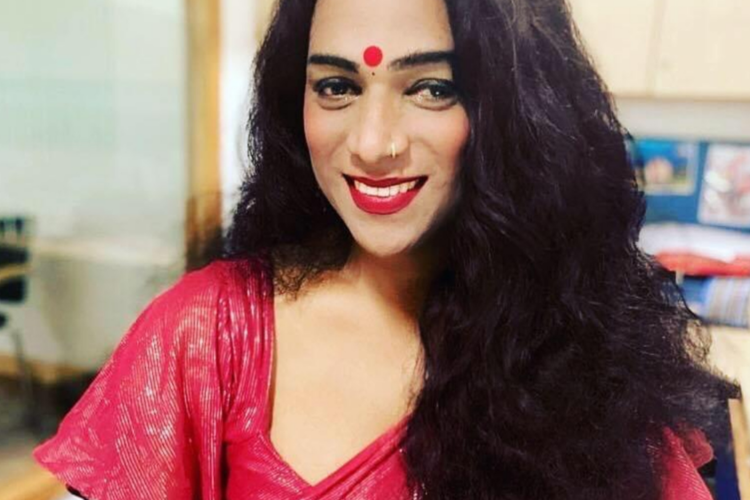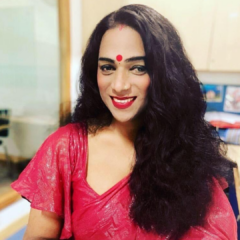19 October 2022, New Delhi, India – As a trans woman growing up in India during my adolescence, I was always questioned about my non-binary clothes and mannerisms by society. I always thought in my childhood that
I am a perfect child of God raised in an imperfect world that is trying to fit me into the binary boxes.
As I grew up, my struggle remained steep, and I was challenged on various platforms for identifying myself as a trans woman and embracing my feminine side before my transition. I was humiliated for having male organs on my body and expressing myself as a woman. Many transgender people in India and across the world still go through extreme misgendering, violence, and lack of acceptance in society because they don’t fit into the gender norms of Western culture.
Today’s society is rampant with transphobia and the erasure of intersex and non-binary communities. A rigid binary of man and woman dictates our lives and is entwined within the very structure of society, so much so that it begins to feel like fact rather than a social construct. But these are myths falsely disseminated by colonial forces to perpetuate and validate eugenics theory. This is not to say that ‘man’ and ‘woman’ are incorrect, just that they are not the only gender identities.
Gender is not just how you express yourself in society and fit into the binaries of this world. The word ‘Gender’ is mainly associated with Women and girls in several progressive countries. However, gender is much more than the binaries in this world. We must claim our culture pre-colonization, which was inclusive and tolerant of gender pluralism and gender diversity.
Another myth is that systemic transphobia has always existed. While it is true that, historically, gender non-conforming individuals may have been treated differently, they have not always been discriminated against in the abhorrent way that we see today. They were revered, and even, worshipped in some societies. More importantly, their existence was not denied so outrightly. Transgender issues seem particularly contemporary in the West. Perhaps this is because of how highly structured Western societies are: every form that needs filling in and every public toilet available demands choosing between being a woman or a man. Or maybe it seems current because being transgender is associated with surgery, and surgeons have been able to change someone’s sex only since the early 1930s. Current debates about same-sex marriage, gender and sexual anti-discrimination laws are also recent advances. Indeed, the very word ‘transgender’ came into common usage only in the past 20 years or so, and even the word ‘gender’ itself was popularised only in the 1970s.(1)
In countries like India, there is historical evidence of recognition of intersex, transgender and gender non-conforming people during the early writings of ancient India. The concept of “tritiya-prakriti” or “napumsaka” (third or other gender) had been an integral part of Hindu mythology, folklore, epic and early Vedic and Puranic literature. While the vocabulary may have been different, ancient India did not think that gender equated to sex, nor did it deny the existence of a gender spectrum. People of the Hijra community were even considered ‘closer to god’ and were invited to bless weddings and newborns.(2) “Bissu” (referenced from a letter written in the year 1544 by a Portuguese Bishop to the Indian State of Goa – “they grow no hair on their beards, dress in a womanly fashion, and grow their hair long and braided; they imitate [women’s] speech because they adopt all of the female gestures and inclinations”) was another nonbinary identity that was very powerful in Indonesia. The bissu bring together woman and man in one person to mediate between humans and gods. They were extremely powerful and, in fact, they were the ones who made the choice in the early 1500s to decide on the conversion of their country’s people between Christianity and Islam, since they were more powerful than the kings who were ruling the country. In Malaysia, there were transgender people known as sida-sida. Like the bissu, the sida-sida were considered to combine female and male properties, and through this combination, they were invested with spiritual power and entrusted to protect high-ranking women and their regalia on palace grounds. Among the Iban people of Borneo, there are the transgender ritual specialists, known as Manang, who are famous as dispute settlers. The Ngaju Dayak, another group in Southeast Asia, recognized the transgender ritual specialists as the basir, while in Burma, there was the nat kadaw. According to Peter Jackson, a scholar at the Australian National University in Canberra, gender was not differentiated in Thailand until the 1800s. Before then, Thai princes and princesses dressed the same, with matching hairstyles. But in the 19th century, to impress the British, the Thai monarchy decided that women and men should be clearly differentiated with unique clothing and hairstyles.
When gender is not strictly mandated to follow a binary, there is no need for individuals to be transgender because there is nothing to transverse. So, in fact, the Western gender system created ‘transgenderism’ – crossing from one gender to another made no sense in Thailand when there weren’t two strictly defined genders. Hence the most well-known transgender identity in Southeast Asia: the kathoey, often referred to by the derogatory term ‘ladyboys’.(3) There are various such identities that prevailed across the Asia region, which were known by different names and characteristics. Gender and gender expressions and sexualities were much celebrated without judgment before the canonization of culturally rich countries.
European colonizers intentionally sought to eradicate what academic and researcher Scott Morgensen refers to in Spaces Between Us: Queer Settler Colonialism and Indigenous Decolonization (2011) as “Indigenous possibilities” that challenged the boundaries of white European masculinity. The earliest colonizers in the Americas looked to the existing sexual and gender variance of Indigenous people as a means of marking them as racially inferior and uncivilized: a justification for a forever unjustified genocidal conquest. Targeting Indigenous gender and sexual variance was done to “teach both colonial and Indigenous subjects the relational terms of colonial heteropatriarchy.” European colonizers marked Indigenous gender and sexual variance as inferior for the purposes of asserting their white cisgender heterosexual manhood as the pinnacle of human existence. Those who were marked as living outside the limited Western understandings of gender and sexuality that were violently imposed upon Indigenous cultures “became targets of violent efforts to reconfigure Indigenous society in colonial and masculinist terms.” White European colonizers forcefully recruited Indigenous men to “defend colonial sexual morality in their own and all Indigenous people’s lives.” Through this violent colonial project, white European men reproduced their ideologies of gender and sexual “normalcy” in Indigenous men to become its new protectors, enforcers, and replicators.(4)
In the past year, we have seen several countries implement laws that recognize diverse gender identities and expand the rights of transgender people. Uruguay is one such example. Countries like India, Pakistan, Nepal, and Bangladesh in the Asia region rapidly understood the need for recognizing third gender, and in all these countries genders beyond binary are recognized as ‘third gender’ or ‘other’. While these countries have recognized their existence and talked about their inclusion in society, they remain silent on exercising ‘civil rights’, i.e., marriage, adoption, and sexual rights for these people. We have also seen major reform on the international stage through multilateral systems and mechanisms. For example, the World Health Organization, a specialized agency of the United Nations, removed transgender identities from the mental health disorders classification in June 2018. The Caribbean Court of Justice ruled in November 2018 that a law in Guyana, which made it a criminal offense to appear in a public place dressed in the clothing of the opposite sex, is unconstitutional.
Despite these historic gains, we are also witnessing a rise in right-wing nationalism and so-called anti-gender movements targeting gender equality, advocating for the exclusion of LGBTIQ people, and extreme restrictions on sexual and reproductive health and rights, with far-reaching consequences. This has led to a rise in queerphobic and, especially, transphobic rhetoric coming from political actors and, in some cases, systematic attempts to roll back progress made in recognizing the diversity of gender identities. At the source of the anti-gender movement is an alarming alliance formed by diverse religious and secular groups that stand against feminist principles and ideals, thus attempting to deny the principle that the root of gender inequality is the social construction of gender roles and norms and that these constructions produce personal and systemic experiences of stigma, discrimination, and violence. Such efforts uphold a patriarchal system in which women’s and gender diverse people’s autonomy and human rights continue to be violated.
Moreover, the hateful and exclusionary rhetoric online, through political platforms and, increasingly, the United Nations, gives the green light for violence against individuals who do not fit the norms advocated by these anti-gender, fundamentalist forces. Organizations monitoring the murder of trans and gender diverse people have noted a stark increase in the murder of trans and gender diverse people in the last several years. As anti-gender actors continue to widen their hateful attacks from local, national, and regional spaces into international forums like the UN, it is vital that feminist organizations and progressive governments continue to stand firm in opposition to such hateful rhetoric and strategize to ensure that we hold the line in the fight for gender equality.(5)(6)
Conservative and religious actors are collaborating nationally and transnationally against so-called ‘gender ideology’. Often referred to as the ‘anti-gender movement’, it is a growing coalition of conservative and religious forces, spreading hateful discourse to wedge public opinion, often targeting LGBTI people and their human rights, sexual and reproductive rights, sexual education, and gender studies. In some countries, the discourse has led to mobilization against significant progressive national reforms.
Discourse about so-called ‘gender ideology’ is increasingly present and growing across the globe. Due to social media and other digital communication tools, these concepts and communication strategies travel fast. Despite some successes, it has so far been challenging for the LGBTI movement to respond effectively and to develop our own narratives to counter attacks. Developing new narratives, framing and testing our messages, are crucial skills if we are to succeed.(7)
Sexuality and gender movements are often linked and should be mobilized jointly around fundamental rights to dignity, bodily autonomy, access to information, the right to live free from violence and discrimination, and freedom of association and expression. Additionally, for transgender people ‘gender affirmation’ is extremely important, as often misgendering is a product of the binary expressions in heteronormative society. We must work towards the ‘gender neutral’ laws, policies, infrastructure, and a society that is based on principles of equal dignity, equity for gender minorities and freedom of gender expression.
_______________________________________________________
(1) https://aeon.co/essays/the-west-can-learn-from-southeast-asias-transgender-heritage
(3) https://aeon.co/essays/the-west-can-learn-from-southeast-asias-transgender-heritage
(5) https://genderit.org/feminist-talk/propping-patriarchy-threats-growing-anti-gender-movement
(6) GenderIT. íbid.
(7) https://www.ilga-europe.org/report/responding-to-anti-gender/






